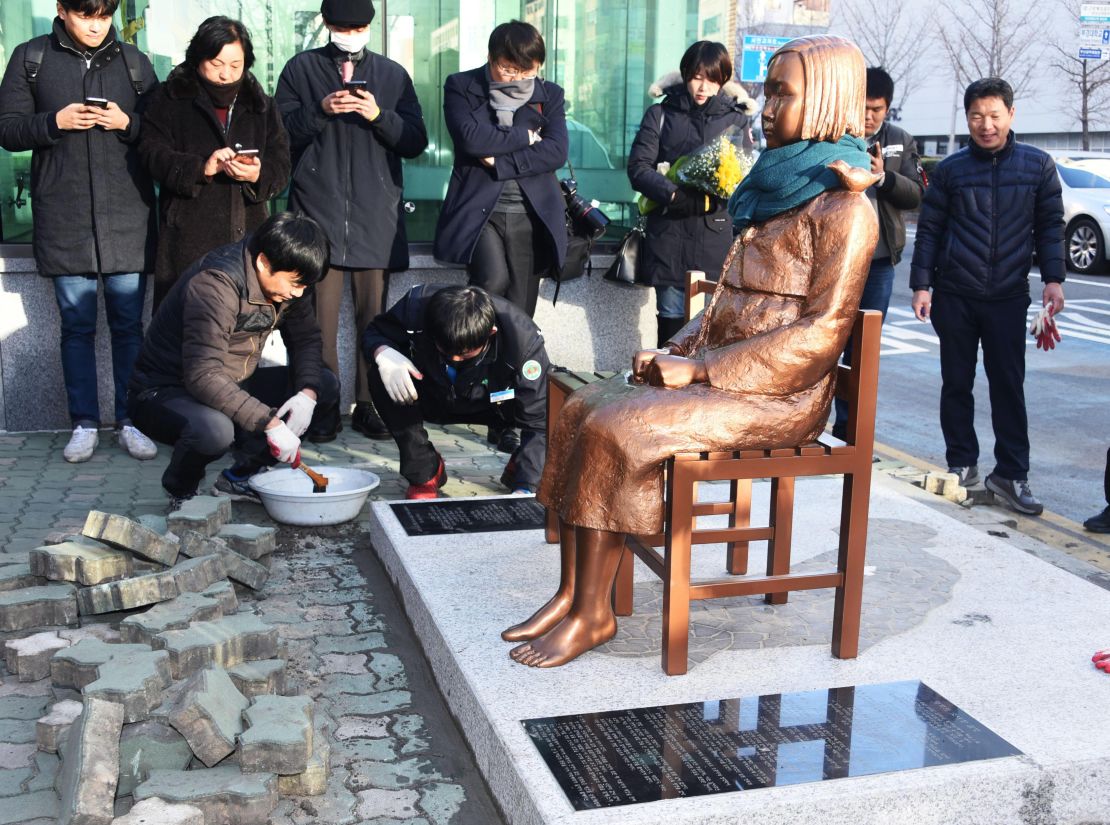In the busy South Korean port city of Busan, the young girl sits on a wooden chair, her fists balled in her lap.
She looks impassively forward, her expression unsmiling and determined. Her feet are bare, and on her shoulder sits a small bird.
This statue has sparked international incidents, threatened trade deals, and exposed deep and bitter rifts between Japan and South Korea that go back more than seven decades.
Diplomatic spat
The first iteration of the statue was unveiled in 2011, outside Japan’s embassy in Seoul, sparking objections and demands that it be removed from the Japanese.
In January, Tokyo recalled two top diplomats from South Korea after an identical statue was erected outside the country’s consulate in Busan, on the grounds that the action breached a 2015 agreement between the two countries intended to settle the “comfort women” issue.
Japan also halted talks on a planned currency swap and delayed high-level economic dialogue as part of an “initial” response to the statue, chief cabinet secretary Yoshihide Suga said.
The statue was erected by a civil group in December to remember “comfort women,” women and girls forced to work as sex slaves for Japanese soldiers during World War II.
'Comfort women' statues around the world
Its inspiration, artists Kim Seo-kyung and Kim Eun-sung told CNN, dates to previous Japanese criticism of a planned memorial.
Initially, they had intended to create a memorial stone for the 1000th Wednesday Demonstration – weekly protests that have been held by surviving “comfort women” outside the Japanese embassy in Seoul since 1992.
“But we heard that the Japanese government was against the memorial stone being built, and this offended us as artists,” Kim Seo-kyung said
The memorial stone plan was replaced by a “statue of peace,” the first of which was erected opposite the Seoul embassy, staring at its doors.
“If the Japanese government didn’t react so excessively, it would probably have just been a small memorial stone,” she said.
There are now dozens of the statues in Korea, and six in other countries, including the US, Canada and Australia, according to the artists.
Wartime crimes
It’s not known exactly how many women served as so-called comfort women but the Japanese government disputes the previously reported number of 200,000.
The use of forced prostitution in Japanese-occupied parts of East Asia was first suggested in 1932 and revived in 1937 after the “Rape of Nanjing” – in which an estimated 300,000 people died during a weeks-long spree of mass killings, rape and looting in the Chinese city. Japan disputes the scale of the incident and the Chinese death toll.
“The rationale … was that such an institutionalized and, therefore, controlled prostitution service would reduce the number of rape reports in areas where the army was based,” according to a UN report on the issue.
To this end, the report said, the Japanese army began recruiting women, by deception, coercion and force, for its brothels.
“A large number of the women victims speak of violence used on family members who tried to prevent the abduction of their daughters and, in some cases, of being raped by soldiers in front of their parents before being forcibly taken off.”
Compensation and apology
Following Japan’s surrender in 1945 and the end of World War II, the complaints of “comfort women” victims went largely unheard.
Tokyo argues that the matter was largely settled in a 1965 treaty that normalized relations with Seoul.
In 1993, Japan admitted that the military was “involved in the establishment and management” of so-called “comfort stations,” and again expressed its “sincere apologies and remorse.”
The issue remained controversial until 2015, when Seoul and Tokyo signed a landmark agreement which saw the Japanese government again offer its apologies, as well as give 1 billion yen ($8.7 million) to a fund to help victims.
“Prime Minister Abe expresses anew his most sincere apologies and remorse to all the women who underwent immeasurable and painful experiences and suffered incurable physical and psychological wounds as comfort women,” the agreement said.
Victims’ groups said the apology did not go far enough in acknowledging government responsibility for the “comfort women” program, and pointed to Japanese history textbooks which underplay the country’s war crimes.
In addition, the two governments would “refrain from criticizing and blaming each other in the international society, including the United Nations,” officials said.
The erection of the statue in Busan, Tokyo argues, breaches this agreement as it required official approval to be installed opposite the consulate.

Reaction
For his part, Kim Eun-sung is stunned by what he regards as Japanese overreaction.
“Which part of a statue of a girl is harming Japan? It’s a statue with a message of peace and for the rights of women,” he said.
He never expected the statue, which was commissioned by a local Busan civic group and paid for with donations, to cause a diplomatic incident.
“It’s something unprecedented, where the Japanese government is interfering so much with (Korean) people setting up a statue in our own country,” Kim said.
In a statement, the group which commissioned the statue said it was installed “in order to request an official apology and legal compensation for Japan’s colonial rule and war crimes, and also to discard the (2015) ‘comfort women’ agreement.”













